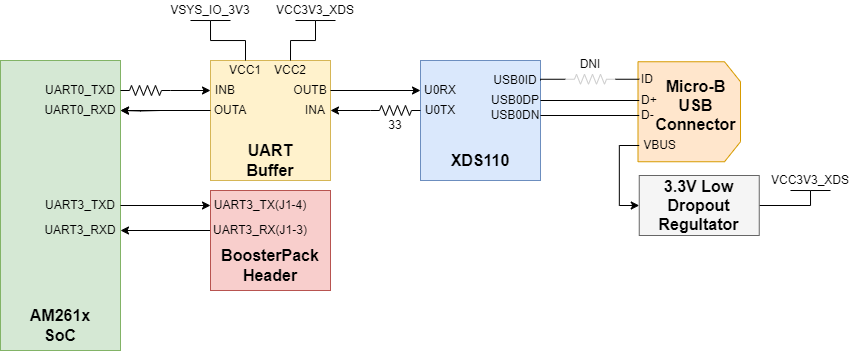SPRUJF1 November 2024 AM2612
ADVANCE INFORMATION
- 1
- Description
- Key Features
- 1LaunchPad Module Overview
-
2Hardware Description
- 3.1 Board Setup
- 3.2 Functional Block Diagram
- 3.3 GPIO Mapping
- 3.4 Reset
- 3.5 Clock
- 3.6 Memory Interfaces
- 3.7 Ethernet Interface
- 3.8 I2C
- 3.9 Industrial Application LEDs
- 3.10 SPI
- 3.11 UART
- 3.12 MCAN
- 3.13 FSI
- 3.14 JTAG
- 3.15 TIVA and Test Automation Pin Mapping
- 3.16 LIN
- 3.17 ADC and DAC
- 3.18 EQEP and SDFM
- 3.19 EPWM
- 3.20 USB
- 3.21 BoosterPack Headers
- 3Known Issues and modifications done on LP-AM261 RevE1
- 4Additional Information
- 5References
- 6Revision History
2.11 UART
The AM261x LaunchPad uses the XDS110 as a USB2.0 to UART bridge for terminal access. UART0 transmit and receive signals of the AM261x SoC are mapped to the XDS110 with a dual channel isolation buffer (ISO7721DR) for translating from the 3.3V IO voltage supply to the 3.3V XDS supply. The XDS110 is connected to a micro-B USB connector for the USB 2.0 signals. ESD protection is provided to the USB 2.0 signals by a transient voltage suppression device (TPD4E02B04DQAR). The micro-B USB connector's VBUS 5V power is mapped to a low dropout regulator (TPS79601DRBR) to generate the 3.3V XDS110 supply. A separate 3.3V supply for the XDS110 allows for the emulator to maintain a connection when power to the LaunchPad is removed.
UART3 instance is mapped directly to the BoosterPack header.
 Figure 2-19 UART
Figure 2-19 UART